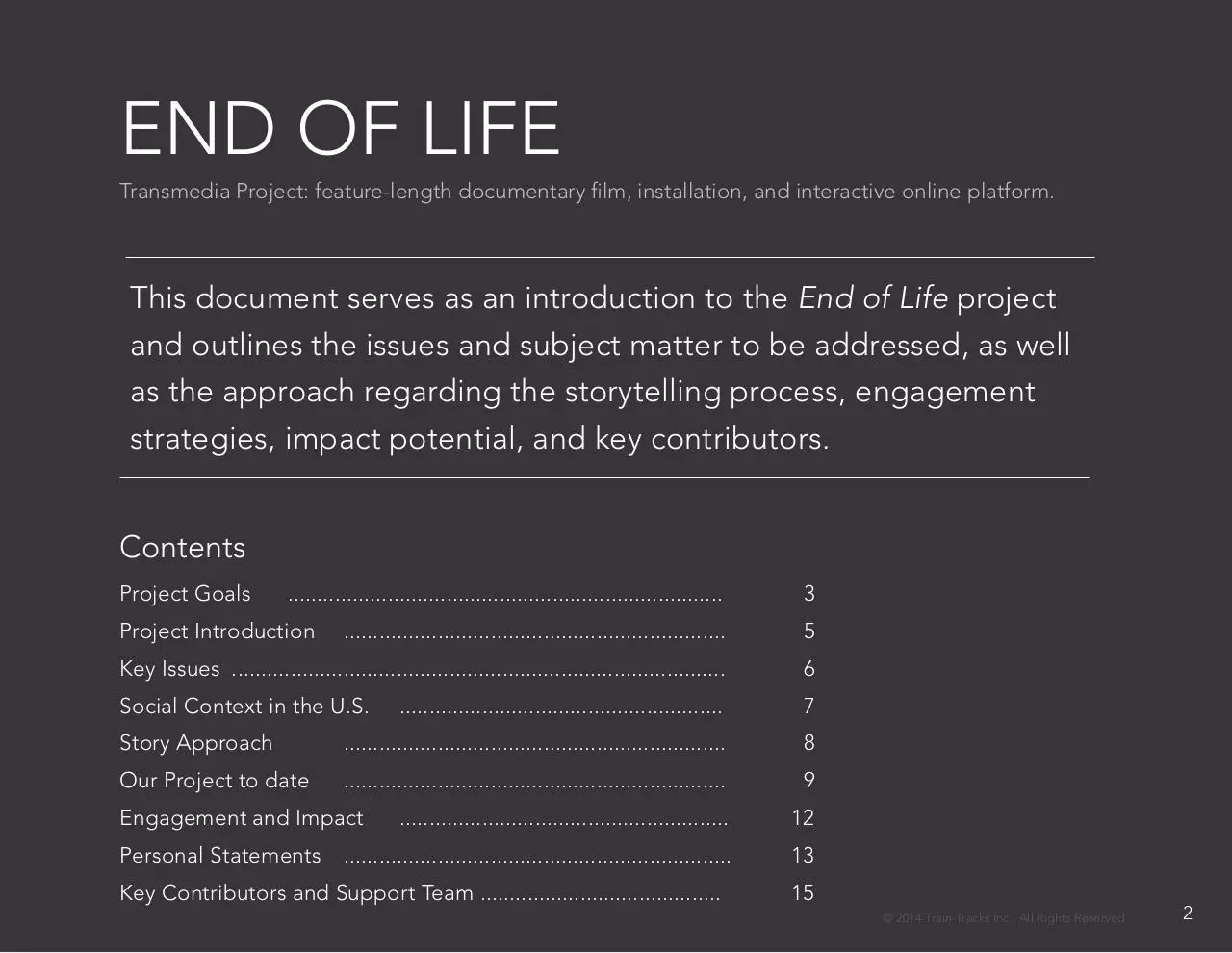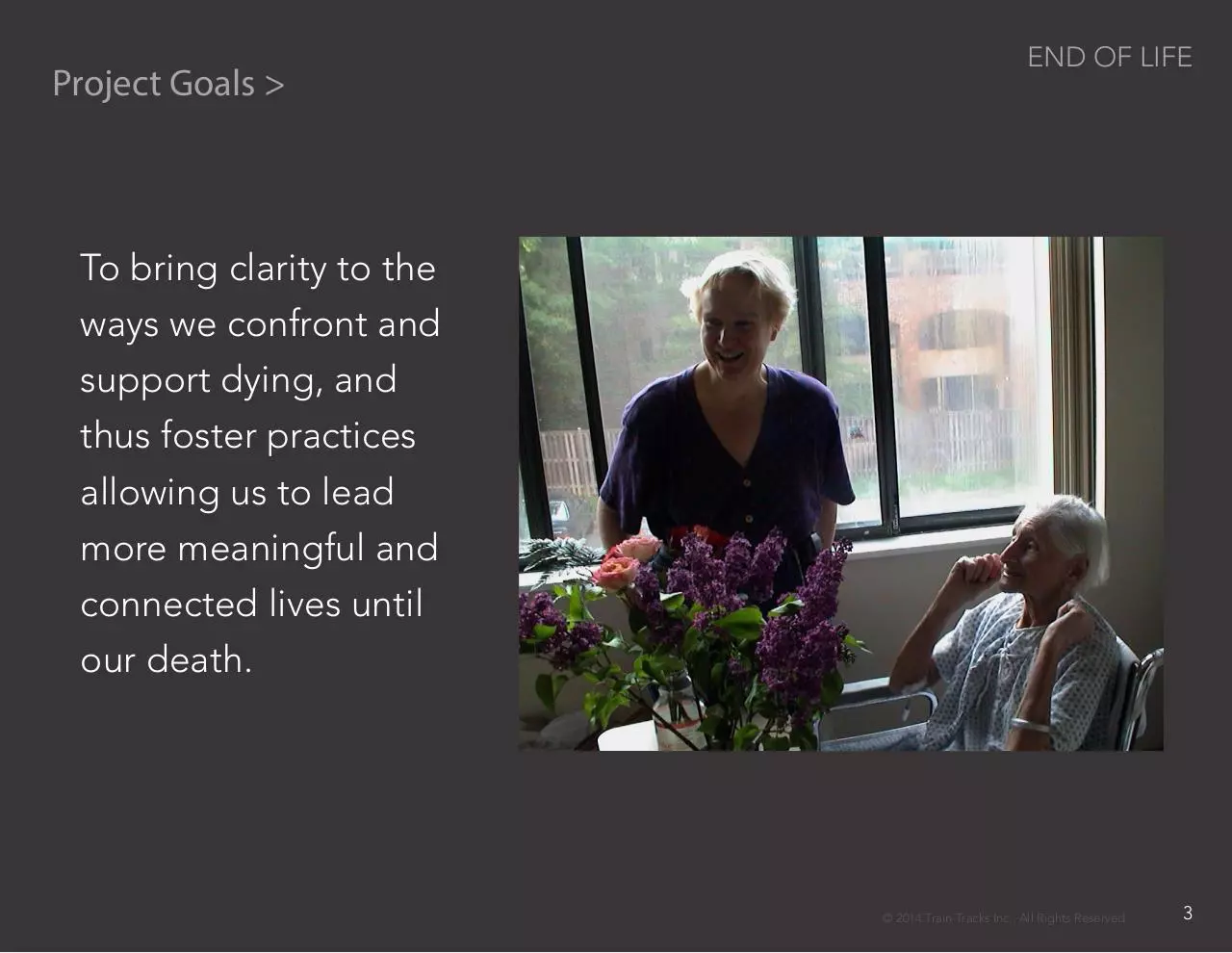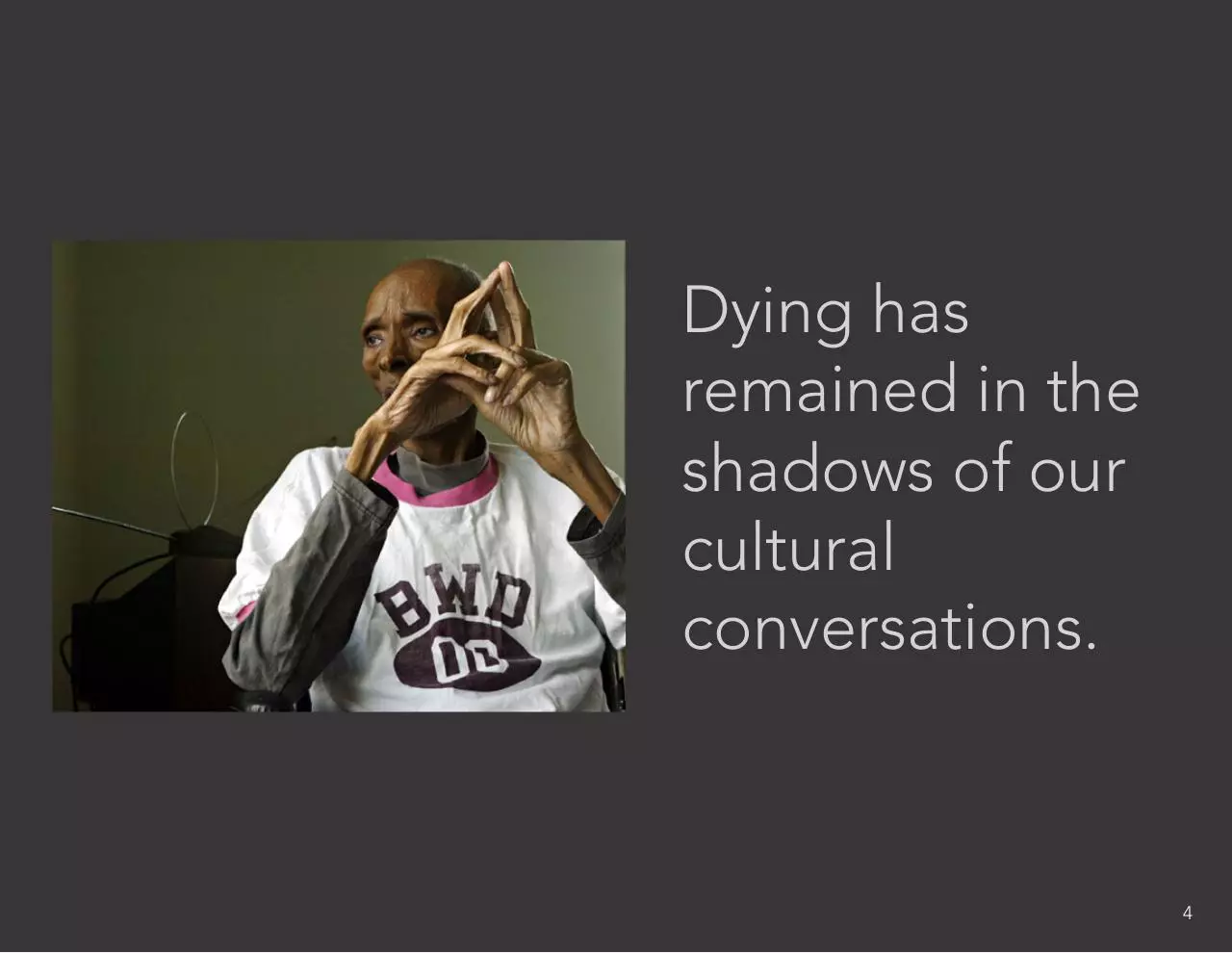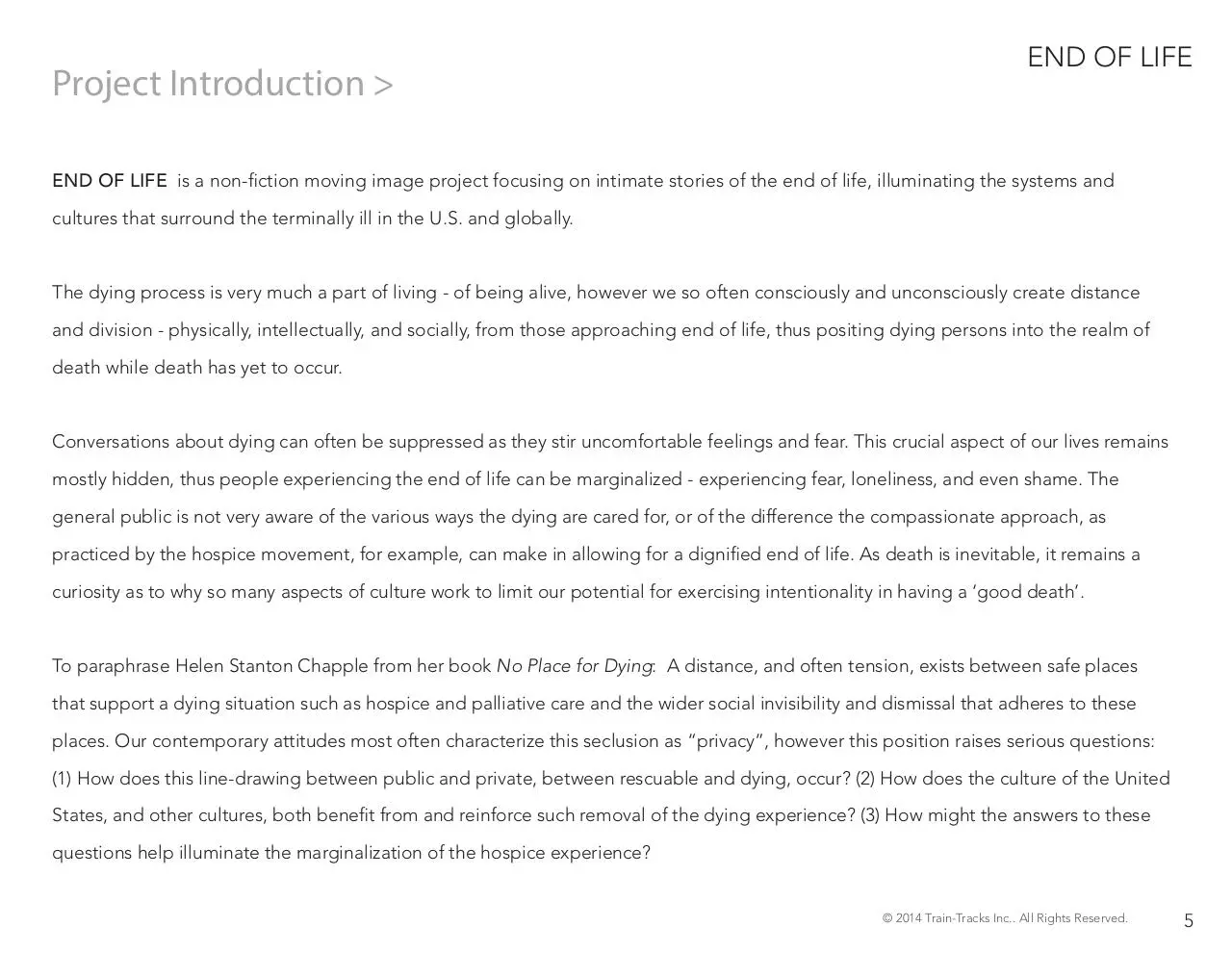EOL Overview 20141029 (PDF)
File information
This PDF 1.4 document has been generated by Adobe InDesign CC 2014 (Macintosh) / Adobe PDF Library 11.0, and has been sent on pdf-archive.com on 10/03/2016 at 03:37, from IP address 108.66.x.x.
The current document download page has been viewed 384 times.
File size: 2.51 MB (17 pages).
Privacy: public file





File preview
END
OF
LIFE
Project Overview
Oct 2014
END OF LIFE
Transmedia Project: feature-length documentary film, installation, and interactive online platform.
This document serves as an introduction to the End of Life project
and outlines the issues and subject matter to be addressed, as well
as the approach regarding the storytelling process, engagement
strategies, impact potential, and key contributors.
Contents
Project Goals
..........................................................................
Project Introduction
3
.................................................................
5
Key Issues ....................................................................................
6
Social Context in the U.S.
.......................................................
7
Story Approach
.................................................................
8
Our Project to date
.................................................................
9
Engagement and Impact
........................................................
12
Personal Statements ..................................................................
13
Key Contributors and Support Team .........................................
15
© 2014 Train-Tracks Inc.. All Rights Reserved.
2
Project Goals >
END OF LIFE
To bring clarity to the
ways we confront and
support dying, and
thus foster practices
allowing us to lead
more meaningful and
connected lives until
our death.
© 2014 Train-Tracks Inc.. All Rights Reserved.
3
Dying has
remained in the
shadows of our
cultural
conversations.
4
Project Introduction >
END OF LIFE
END OF LIFE is a non-fiction moving image project focusing on intimate stories of the end of life, illuminating the systems and
cultures that surround the terminally ill in the U.S. and globally.
The dying process is very much a part of living - of being alive, however we so often consciously and unconsciously create distance
and division - physically, intellectually, and socially, from those approaching end of life, thus positing dying persons into the realm of
death while death has yet to occur.
Conversations about dying can often be suppressed as they stir uncomfortable feelings and fear. This crucial aspect of our lives remains
mostly hidden, thus people experiencing the end of life can be marginalized - experiencing fear, loneliness, and even shame. The
general public is not very aware of the various ways the dying are cared for, or of the difference the compassionate approach, as
practiced by the hospice movement, for example, can make in allowing for a dignified end of life. As death is inevitable, it remains a
curiosity as to why so many aspects of culture work to limit our potential for exercising intentionality in having a ‘good death’.
To paraphrase Helen Stanton Chapple from her book No Place for Dying: A distance, and often tension, exists between safe places
that support a dying situation such as hospice and palliative care and the wider social invisibility and dismissal that adheres to these
places. Our contemporary attitudes most often characterize this seclusion as “privacy”, however this position raises serious questions:
(1) How does this line-drawing between public and private, between rescuable and dying, occur? (2) How does the culture of the United
States, and other cultures, both benefit from and reinforce such removal of the dying experience? (3) How might the answers to these
questions help illuminate the marginalization of the hospice experience?
© 2014 Train-Tracks Inc.. All Rights Reserved.
5
Key Issues to be addressed >
END OF LIFE
How might our society evolve to actively
address the cultural and systemic
deficiency of compassionate care for
the dying.
How might we embrace end of life in
ways that do not marginalize the
terminally ill.
In what ways might we shift from
our current lack of information and
resources regarding ways to navigate
Photo by Nan Goldin
options for end of life.
© 2014 Train-Tracks Inc.. All Rights Reserved.
6
Social Context in the U.S. >
END OF LIFE
The composition of the U.S. population in regard to age will shift dramatically in the 21st Century: for the first time in the nation’s
history more than 20% of people in U.S. will be 65 years old and over. The rate of this shift is occurring at an unusual pace due to
the impact of aging Baby Boomers. For example, in 2007 the U.S. population age 65 and over was 12%, with projections for this
demographic to reach 20% before the year 2040. The systemic strain on an already complex and flawed health care infrastructure
can be profound.
© 2014 Train-Tracks Inc.. All Rights Reserved.
7
Story Approach >
END OF LIFE
Our story focuses on people at the end of life, the spaces they inhabit, and the lines that are drawn between the systems
surrounding life and the systems surrounding imminent death. It is this created distance between the living and the dying that we
wish to illuminate in order to move conversations concerning end of life toward perspectives that will further our humanity. We will
focus on ideas of space and place impacting the end of life process through an ethnographic approach of empathetic participation
with a collection of end of life situations in a variety of contexts.
Our exploration of people experiencing end of life will include persons representing a variety of groups with regard to age, socioeconomic status, and ethnicity. The role of various religious faiths, practices, and end of life rituals will factor into some of these
cases, as well as a variety of urban, suburban and rural contexts. While most stories will take place in America, we will also capture
stories in India, Canada, Thailand, and Mexico.
We will approach the filming process with a “beginner’s mind,” being open to the person experiencing end of life as well as
remaining alert to our own preconceived notions and fears as they arise. In this way those who are “actively” dying - the characters
of our project, and those whose death is not yet imminent - the filmmakers, may come to inhabit a shared space. We sense that this
space may become the true subject of the film.
The portraits of the dying will also sometimes involve the caregivers such as physicians, nurses, aides as well as family members.
We will document the dying as they relate to others, and also alone, during moments of silence and introspection. Whether they
feel like speaking to the camera or not, we will record both situations equally. We aspire to be silent witnesses, cognizant of the fact
of our intrusion into an inconceivably challenging situation. Our aim is to produce a work that is a quiet, formally rigorous testament
to the dignified, mysterious, potentially frightening and wondrous experience that dying can be.
© 2014 Train-Tracks Inc.. All Rights Reserved.
8
Our Project to date >
END OF LIFE
As organ failure progresses, Doris could transition quickly
into an active dying phase. She has had a challenging family
life, save for Richard who has long been her support. “We’re
old friends,” he says about his mother. “I’m always happy to
help you with your projects,” she gestures to our cameras.
Richard, an artist, has involved Doris in many of his films and
performance pieces over the years. Now, he navigates the
many decisions surrounding Doris’ comfort versus simply
Doris Johnson, age 82, recognizes the beauty of her son
Richard’s eyes whenever he smiles, “they crinkle, like you’re
keeping her body alive. Richard and Doris communicate in a
graceful dance around history and the present moment.
another Clark Gable.” Yet, a moment later she believes that
he is her brother, the result of the dementia she suffers. Most
of the time, Doris is chipper and playfully sarcastic when we
visit the Bronx nursing home where she has resided for the
past three years. She reaches for her ID braclet, over and over,
wondering why she can’t tell the time, as though it were a wrist
watch. An arrangement of plastic flowers might need water,
she warns, despite Richard’s gentle and repeated explanation
that the arrangement is fake.
© 2014 Train-Tracks Inc.. All Rights Reserved.
9
Download EOL Overview 20141029
EOL Overview 20141029.pdf (PDF, 2.51 MB)
Download PDF
Share this file on social networks
Link to this page
Permanent link
Use the permanent link to the download page to share your document on Facebook, Twitter, LinkedIn, or directly with a contact by e-Mail, Messenger, Whatsapp, Line..
Short link
Use the short link to share your document on Twitter or by text message (SMS)
HTML Code
Copy the following HTML code to share your document on a Website or Blog
QR Code to this page

This file has been shared publicly by a user of PDF Archive.
Document ID: 0000347990.